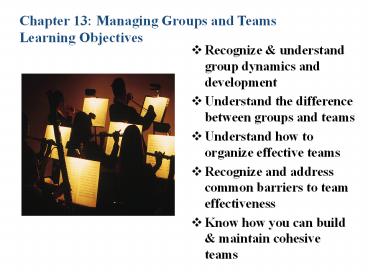Chapter 13: Managing Groups and Teams Learning Objectives PowerPoint PPT Presentation
Title: Chapter 13: Managing Groups and Teams Learning Objectives
1
Chapter 13 Managing Groups and Teams Learning
Objectives
- Recognize understand group dynamics and
development - Understand the difference between groups and
teams - Understand how to organize effective teams
- Recognize and address common barriers to team
effectiveness - Know how you can build maintain cohesive teams
2
Group and Team Management in the P-O-L-C
Framework
3
(No Transcript)
4
Types of Groups Formal and Informal
5
(No Transcript)
6
(No Transcript)
7
(No Transcript)
8
(No Transcript)
9
Social Loafing and Collective Efficacy
10
(No Transcript)
11
(No Transcript)
12
(No Transcript)
13
Three Major Classes of Team Tasks
14
(No Transcript)
15
Team Role Typology
- These 10 roles include task roles (light yellow),
social roles (medium orange), and boundary
spanning roles (dark orange)
16
- A task force is a temporary team which is asked
to address a specific issue or problem until it
is resolved - A product development team can be temporary or
ongoing - A cross-functional team appears in matrix
organizations where individuals from different
parts of the organization staff the team which
may be temporary or long standing in nature
17
- Upwards of 8.4 million individuals worldwide work
virtually in at least one team - virtual teams are formed to take advantage of
distributed expertise or time - Challenges of Virtual Teams
- Building trust is difficult
- If individuals in a virtual team are not fully
- engaged and tend to avoid conflict,
- team performance can suffer
18
Team leadership is a major determinant of how
autonomous a team can be
19
Designing Effective Teams
20
(No Transcript)
21
(No Transcript)
22
(No Transcript)
23
(No Transcript)
24
(No Transcript)
25
Building Your Cohesive Team
PowerShow.com is a leading presentation sharing website. It has millions of presentations already uploaded and available with 1,000s more being uploaded by its users every day. Whatever your area of interest, here you’ll be able to find and view presentations you’ll love and possibly download. And, best of all, it is completely free and easy to use.
You might even have a presentation you’d like to share with others. If so, just upload it to PowerShow.com. We’ll convert it to an HTML5 slideshow that includes all the media types you’ve already added: audio, video, music, pictures, animations and transition effects. Then you can share it with your target audience as well as PowerShow.com’s millions of monthly visitors. And, again, it’s all free.
About the Developers
PowerShow.com is brought to you by CrystalGraphics, the award-winning developer and market-leading publisher of rich-media enhancement products for presentations. Our product offerings include millions of PowerPoint templates, diagrams, animated 3D characters and more.

